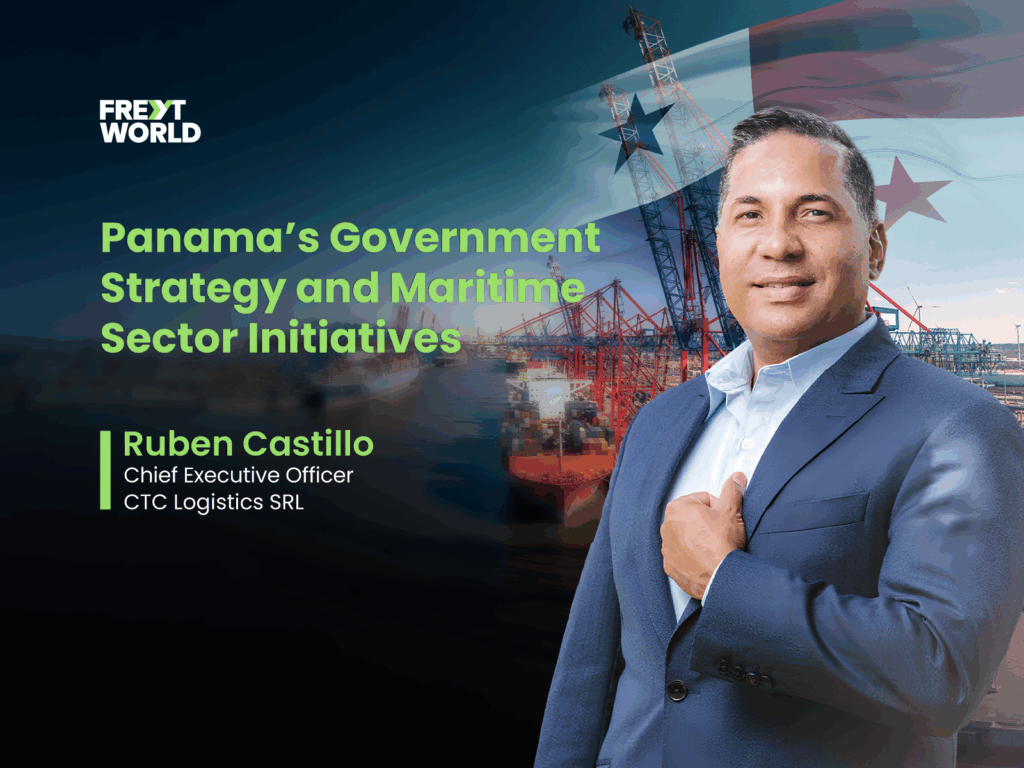By Ruben Castillo, Chief Executive Officer of CTC Logistics SRL

Panama’s maritime and logistics sectors are at a turning point. The country’s strategic position as a global logistics hub grows stronger as the government launches initiatives, digital upgrades, and infrastructure projects. These efforts aim to secure Panama’s leadership in global shipping, boost operational efficiency, and tackle emerging international trade challenges.
This analysis reviews the latest developments, supported by data and forecasts from 2024–2025, and considers their implications for the logistics industry.
A Renewed Maritime and Logistics Strategy
The government of Panama has articulated a clear vision for the future of its maritime and logistics sectors. In 2024 and 2025, a new integrated strategy was introduced, focusing on technological innovation, regulatory modernization, and infrastructure resilience. The Panama Maritime Authority (AMP) is at the core of this transformation, with a mandate to ensure the country remains competitive in the face of shifting global trade patterns and regulatory demands.
A $25M loan was approved for AMP, with $3M set aside to update Panama’s outdated National Maritime Strategy from 2016. The review aims to measure gains from port expansion and align Panama’s maritime sector with current global standards and practices. Local and global experts will help shape the strategy, reaffirming Panama’s focus on staying competitive in global maritime leadership.
Digital Transformation and Regulatory Modernization
A defining feature of Panama’s current strategy is the emphasis on digital transformation. The rollout of the Electronic Vessel Registry (REN) marks a significant milestone in the modernization of maritime administration. The REN system streamlines vessel registration processes, reduces bureaucratic hurdles, and enables real-time interaction with global maritime stakeholders. This initiative should enhance the efficiency and transparency of Panama’s ship registry, already the largest in the world by tonnage.
The AMP is also investing in advanced monitoring systems for Panamanian-flagged vessels. A project valued at $1.4 million will provide 24-hour tracking capabilities, improving the ability to identify and respond to illicit activities such as unauthorized fuel transfers. These measures are designed to reinforce Panama’s reputation as a responsible flag state and to prevent the misuse of its registry for activities that could undermine global maritime security.
Strengthening the Panama Ship Registry
Panama’s ship registry is a cornerstone of its maritime economy, with 8,822 vessels currently flying the Panamanian flag. In 2024, the registry recorded a net growth of 468 vessels, closing the year with 8,773 ships and 248.8 million Gross Register Tonnage (GRT). The registration of 408 newly built ships, contributing over 9.4 million GRT, underscores the attractiveness of the Panamanian flag to modern, sustainable vessels.
The AMP has implemented a rigorous oversight regime to ensure compliance with international safety and environmental standards. Recent evaluations indicate a 96.5% compliance rate with key international frameworks, including the Paris, Tokyo, Mediterranean, Indian Ocean, Black Sea, US Coast Guard, Caribbean, Riyadh, and Viña del Mar agreements. Vessels that fail to meet these standards are systematically removed from the registry, reinforcing the quality and credibility of the Panamanian fleet.
Enhancing Oversight and Compliance
In 2025, Panama introduced stricter controls on ship-to-ship (STS) oil transfer operations involving Panamanian-flagged tankers. The new regulations require vessels with a gross tonnage of 150 or more to notify the flag state at least 48 hours in advance of any planned STS operation. Detailed technical, logistical, and operational information must be provided, including vessel identification, coordinates, type and quantity of hydrocarbons, transfer method, and contact details of the designated person ashore. These measures aim to combat the use of “shadow fleets” and ensure Panama remains a responsible player in global maritime trade.
The AMP further shows its commitment to transparency and compliance through ongoing efforts to recover owed wages for seafarers. In 2025, the authority recovered $8.5 million in wages, reinforcing its reputation for protecting the rights of maritime workers.
Port Infrastructure and Capacity Expansion
Port activity remains central to Panama’s maritime achievements. The country’s transshipment hub continues to see growing volumes, driven by increased global trade and the expansion of port facilities. The AMP has set an ambitious target to recover more than 50% of its port structures within the next five years, ensuring that Panama’s ports remain competitive and capable of handling the demands of modern shipping.
The government is also reviewing port concession contracts, recognizing them as a vital source of income and a key component of the national maritime strategy. These contracts are being assessed to maximize value for the Republic and to ensure that Panama’s ports are managed in line with international standards.
The Panama Canal: A Model of Innovation and Resilience
The Panama Canal is celebrating 25 years of successful Panamanian administration. The Canal’s leadership has prioritized innovation, transparency, and customer satisfaction, ensuring that it remains a cornerstone of international commerce. Ongoing investments in infrastructure, such as plans for a new reservoir to address water scarcity, are critical to the Canal’s long-term reliability.
The Canal Authority launched business initiatives like the LoTSA program and updated Maritime Services Rates to expand corridor logistics and meet global shipper needs. They back these efforts with a strong commitment to environmental sustainability and operational excellence.
Employment and Workforce Development
The maritime, logistics, and port sectors are significant employers in Panama. In early 2025, employment contracts for Panamanian seafarers rose 12% compared to the same period in 2024. The increase stems from partnerships with top shipping firms and improved seafarer training, education, and international maritime collaboration efforts.
The government is collaborating with educational institutions to update the Maritime Baccalaureate curriculum and to develop a centralized database of maritime job opportunities. These initiatives are intended to ensure that Panama’s workforce is prepared for the demands of a rapidly evolving industry.
Strategic Partnerships and International Engagement
Panama’s maritime strategy is strengthened through active collaboration with international partners and participation in global industry events such as BARISHIP 2025. These engagements allow Panama to showcase its advancements in digital transformation, regulatory modernization, and infrastructure development, while fostering dialogue with global leaders in shipping and logistics. By hosting forums and joining international exhibitions, Panama reinforces its role as a key player in shaping the future of maritime trade and governance.
In addition to these platforms, Panama is cultivating strategic alliances with maritime administrations, shipping companies, and global organizations to enhance regulatory alignment and promote sustainable practices. These partnerships support technical cooperation, workforce development, and investment in maritime infrastructure, ensuring Panama remains competitive and resilient. Through these efforts, the country demonstrates its commitment to responsible maritime leadership and positions itself for continued growth in the global logistics arena.
Challenges and Opportunities
While Panama’s maritime and logistics sectors are performing strongly, several challenges remain. They must invest and innovate to stay compliant, tackle Canal water issues, and keep its port infrastructure competitive.
At the same time, digital upgrades, port expansion, and job growth offer Panama key opportunities to strengthen its logistics leadership.
The Outlook for Panama’s Logistics Industry
Panama’s government strategy and maritime sector initiatives are setting a new standard for the logistics industry. The focus on digital transformation, regulatory modernization, and infrastructure resilience will drive continued growth and innovation in the coming years.
The country’s ability to adapt to changing global trade patterns, invest in workforce development, and maintain high standards of compliance will be critical to its long-term success. As Panama grows, its maritime and logistics sectors stand ready to meet the demands of a globalized economy.

Freyt World Blog Contributor
Freyt World is a global logistics network uniting members from around the world. Our mission is to revolutionize global logistics through collaboration and innovation. Our platform goes beyond networking, enabling members to excel and grow together, featuring articles by logistics professionals for their peers. This series will cover industry-relevant issues and news, providing valuable insights for professionals in the field.


